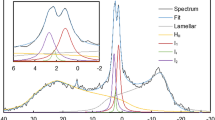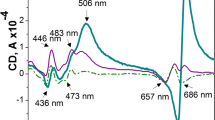Abstract
Chloroplast thylakoid lipids have been isolated free of photosynthetic pigments using a combination of high performance liquid and thin layer chromatography. The hydrophobic fluorescent probe, 1,6-diphenyl-1,3,5-hexatriene (DPH) has been incorporated into aqueous dispersions of the isolated lipids in order to investigate dynamic and structural properties of the resulting bilayer membranes. Time dependent fluorescence anisotropy decays have been measured and analysed assuming the wobbling-in-cone model (Kinosita et al., Biophys J 20 (1977) 289–305). The DPH fluorescence lifetimes and the static and dynamic fluorescence anisotropy decay parameters for the probe in a total lipid mixture or in pure digalactosyldiacylglycerol (DGDG), changed in a predictable way with increasing temperature (10°–36°C). For a given temperature, it was found that the total lipid mixture was in general less ordered and showed greater dynamic motion as judged from DPH fluorescence anisotropy and compared with the pure DGDG system, although at 36°C differences in dynamic parameters were less evident. Overall the results obtained emphasize the highly fluid nature of thylakoid membrane lipids and give a basis for investigating how intrinsic proteins modify structural and dynamic properties of the in vivo membrane.
Similar content being viewed by others
References
Anderson JM (1981) Consequences of the spatial separation of photosystem 1 and 2 in thylakoid membranes of higher plant chloroplasts. FEBS Letts 124: 1–10
Anderson JM (1982) Distribution of the cytochromes of spinach chloroplasts between the appressed membranes of grana stacks and stroma-exposed thylakoid region. FEBS Letts 138: 62–66
Andersson B (1978) Separation of spinach chloroplast lamellae fragments by phase partition including the isolation of inside-out thylakoids. Ph.D. Thesis, University of Lund, Sweden
Arnon DI (1949) Copper enzymes in isolated chloroplasts. Polyphenol oxidase in Beta vulgaris. Plant Physiol 24: 1–15
Barber J (1980) An explanation for the relationship between salt-induced thylakoid stacking and the chlorophyll fluorescence changes associated with changes in spillover of energy from photosystem II to photosystem I. FEBS Lett 118: 1–10
Barber J (1982) Influence of surface charges on thylakoid structure and function. Ann Rev Plant Physiol 23: 261–295
Barber J (1983) Photosynthetic electron transport in relation to thylakoid membrane composition and organisation. Plant Cell and Environment 6: 311–322
Chapman DJ, DeFelice JG and Barber J (1983) Influence of winter and summer growth conditions on leaf membrane lipids of Pisum sativum. Planta 157: 218–223
Chapman DJ, DeFelice JG and Barber J (1983) Growth temperature effects on thylakoid membrane lipids and protein content of pea chloroplasts. Plant Physiol 72: 225–228
Chen LA, Dale RE, Roth S and Brand L (1977) Nanosecond time-dependent fluorescence depolarization of diphenylhexatriene in dimyristoyllecithin vesicles and the determination of “micro-viscosity”. J Biol Chem 252: 2163–2169
Cox RP and Andersson B (1981) Lateral and transverse organization of cytochromes in the chloroplast thylakoid membrane. Biochem Biophys Res Comm 103: 1336–1342
Ford RC (1982) The role of lipid fluidity in the function of the thylakoid membrane. Ph.D. Thesis, University of London, U.K.
Ford RC and Barber J (1980) The use of diphenyl hexatriene to monitor the fluidity of the thylakoid membrane. Photobiochem Photobiophys 1: 263–270
Ford RC and Barber J (1983) Time-dependent decay and anisotropy of fluorescence from diphenyl hexatriene embedded in the chloroplast thylakoid membrane. Biochim Biophys Acta 722: 341–348
Ford RC, Chapman DJ, Barber J, Pedersen JZ and Cox RP (1982) Fluorescence polarization and spin label studies of the fluidity of stromal and granal chloroplast membranes. Biochim Biophys Acta 681: 145–151
Ghirardi ML and Melis A (1983) Localization of photosynthetic electron transport components in mesophyll and bundle sheath chloroplasts from Zea mays. Arch Biochem Biophys 224: 19–28
Gounaris K (1983) Factors affecting lipid structures and stability of photosynthetic membranes of higher plant chloroplasts. Ph.D. Thesis, University of London, U.K.
Gounaris K, Sen A, Brain APR, Quinn PJ and Williams WP (1983) The formation of non-bilayer structures in total polar lipid extracts of chloroplast membranes. Biochim Biophys Acta 728: 129–139
Haehnel W (1982) On the functional organisation of electron transport from plastoquinone to photosystem 1. Biochim Biophys Acta 682: 245–257
Kates M (1972) Techniques of Lipidology. In: Laboratory Techniques in Biochemistry and Molecular Biology (Work TS and Work E eds.), Vol. 3, part 11: 393–469, North Holland, London
Kawato S, Kinosita K and Ikegami A (1977) Dynamic structure of lipid bilayers studied by nanosecond fluorescence techniques. Biochemistry 16: 2319–2324
Kawato S, Kinosita K and Ikegami A (1978) Effect of cholesterol on the molecular motion on the hydrocarbon region of lecithin bilayers studied by nanosecond fluorescence techniques. Biochemistry 17: 5026–5031
Kinosita K, Kawato S and Ikegami A (1977) A theory of fluorescence polarization decay in membranes. Biophys J 20: 289–305
Kirk JTO and Tilney-Bassett RAE (1978) Chloroplast lipids. In: The Plastids, 2nd ed., pp. 50–63, Elsevier/North Holland, Amsterdam
Nakatani HY and Barber J (1977) An improved method for isolating chloroplasts retaining their outer membranes. Biochim Biophys Acta 461: 510–512
Quinn PJ and Williams WP (1983) The structural role of lipids in photosynthetic membranes. Biochim Biophys Acta 737: 223–266
Shipley GG, Green JP and Nichols BW (1973) The phase behaviour of monogalactosyl, digalactosyl and sulphoquinovosyl diglycerides. Biochim Biophys Acta 311: 531–544
Stubbs CD, Kouyama T, Kinosita K and Ikegami A (1981) Effect of double bonds on the dynamic properties of the hydrocarbon region of lecithin bilayers. Biochemistry 20: 4257–4262
Uchida T, Nagai Y, Kawasaki Y and Wakayama N (1981) Fluorospectroscopic studies of various ganglioside and ganglioside-lecithin dispersions. Steady-states and time-resolved fluorescence measurements with 1,6-diphenyl-1,3,5-hexatriene. Biochemistry 20: 162–169
Williams JP and Merrilees PA (1970) The removal of water and non-lipid contaminants from lipid extracts. Lipids 5: 367–370
Author information
Authors and Affiliations
Rights and permissions
About this article
Cite this article
Millner, P.A., Mitchell, R.A.C., Chapman, D.J. et al. Fluidity properties of isolated chloroplast thylakoid lipids. Photosynth Res 5, 63–76 (1984). https://doi.org/10.1007/BF00018375
Received:
Revised:
Issue Date:
DOI: https://doi.org/10.1007/BF00018375




